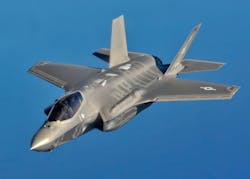As I read and reviewed the then-freshly written special report on Mil/Aero test featured in our August print issue of Evaluation Engineering, one particular theme struck a chord with me: the overall movement toward more electric aircraft (MEA).
The benefits of the MEA movement are many, with the major ones including improvements in aircraft weight, fuel efficiency, reduced operation noise, lower total life cycle costs, lower maintenance costs, and better overall aircraft reliability.
But as with the increasing electrification of so many other technologies we use in our every day lives, the engineering challenges have progressed hand-in-hand. Perhaps the biggest among the global MEA market is the need for large amounts of electric power for systems and the struggle to achieve full efficiency with the current technologies available in power electronics. As part of this, thermal management is a major challenge, as electric systems generate a large amount of heat which needs to be relegated into a heat sink for an aircraft to operate safely.
But even with these challenges, MEA has seen widespread acceptance and application by various military around the world. Besides its operational and maintenance benefits, a major positive MEA can provide is silent electric engine operation. This enables aircraft to fly at low altitude undetected and has led to particular implementation in small electric aircraft and unmanned aerial vehicles.
The vendors included in this issue’s Mil/Aero test special report touch on the technology challenges that MEA brings, as they relate to the testing solutions vendors provide for Mil/Aero applications. The report spans six pages and is a long read, but is packed with great information throughout. A full dozen vendors’ commentaries are included, and while that tells us at Evaluation Engineering that Mil/Aero test is a huge topic for our audience, it presents the editorial challenge of fitting all that commentary into a feature that’s not novel length. Given the great response for this topic and its broad nature, we’ll consider doing two Mil/Aero special reports in 2020 and having each take a more defined focus.
Staying on the topic of Mil/Aero test, I’m excited to attend AUTOTESTCON, which will be held Aug. 26-29 in National Harbor, MD. While certainly not one of the larger industry events in terms of the amount of vendors exhibiting, AUTOTESTCON is much more focused. I attended SEMICON West July 8-10 in San Francisco, where nearly 500 exhibitors spanned everything from semiconductor design, inspection, and test, to sensors. Meanwhile, AUTOTESTCON 2019 is set to have only 50+ vendors exhibiting, but nearly all of them are directly involved with Mil/Aero test applications in some capacity and are the type of vendor the EEBesides covering this topic in-depth once or twice a year in our special reports, we’re always looking for contributed educational content on Mil/Aero test to publish any time of the year. Whether it’s a shorter blog post, a brand new article, or an existing whitepaper that can be condensed into an informative piece, we’d be happy to share it with our audience. Just shoot me an email at [email protected] and tell me what you have in mind.
About the Author

